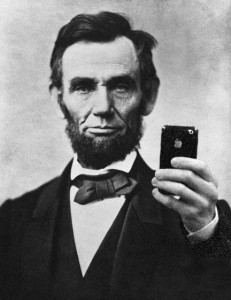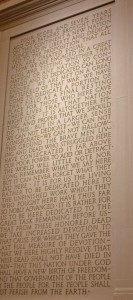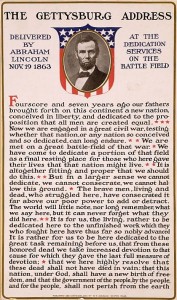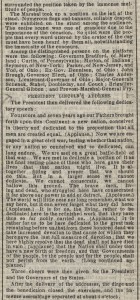
Recently, I started following a new podcast from Slate.com called Lexicon Valley. The half hour-long, weekly podcast by Bob Garfield and Mike Vuolo covers a variety of topics but all of the episodes center around changes in language and the power of words. Their June 4th episode was devoted to Abraham Lincoln and his Gettysburg Address and I highly recommend giving it a listen. While Vuolo and Garfield conclude that the Gettysburg Address closely follows the structure of an ancient Greek funeral oration, they also note that the brevity of the address was both rhetorically deft and politically pragmatic. The address was reprinted verbatim on the front page of most major newspapers and was easily reproducible in every format imaginable– from pamphlets to marble plaques. Today, we can share huge amounts of information with little-to-no effort, yet the art of keeping it brief seems to hold sway. What are some of the unique properties of brevity that makes it so alluring and what can we expect to achieve with it?

There’s a reason the Gettysburg Address is called an “address” and not a “speech”- its was only 246 words long and took a little over two minutes to deliver. Brevity has its benefits; more people are willing to engage with something that requires a short time commitment or is easy to grasp. Social movements, from the Protestant Reformation, to the American Revolution to the Arab Spring, have relied on pamphleteering to spread an idea and change minds. Uncritical futurists might say that the pamphlet has been replaced with social networking, but paper can still be found in the hands of protestors from Cairo to New York City. Pamphlets are usually written in plain language and take a few minutes to read. Memes, short videos, and hashtags also serve this purpose (among many other things). New technologies, whether it is the printing press, the telegraph, or Twitter can help us say a lot with very little.
Brevity has always had its place alongside longer and more nuanced work. Luther and other Protestant reformers wrote lots of pamphlets, but they also translated bibles and wrote long treatise about one’s relationship to God. Just as the printing press was good for both long and short-form media, the Internet lets us create and distribute a wide range of ideas in various formats. Full documentaries can be uploaded to YouTube and Vimeo, and full books can be published through ePub formats. Now, following the lead of services like Instapaper, everyone from Apple to Amazon have begun offering services and tools that make reading longer pieces more comfortable. (On a personal note, I’ve used most of these services and I find Readability to be my favorite. Their “send to Kindle” feature has actually made the reader useful to me again.)

Last week I wrote a (brief!) note on emoticons, in which I noticed that even when children aren’t texting they choose to use emoticons to express a certain tone. Also last week, Nathan Jurgenson wrote about learning the value of missing out: “…the value that users provide on social media happens precisely when they do slow down, when they log off, when they concentrate and when they ‘miss out’ on some things in order to more fully engage with others.” Taking in long-form media and slowing down to fully enjoy it is absolutely necessary for a well-balanced personal life as well as a well-informed public. But short form media and communication should not be discounted as superficial or (as the New York Times would say) a total waste. Brevity should not be confused with the simple. Brief and concise language can do the same –if not more– than verbose prose. Marx didn’t expect everyone to read all the volumes of Das Kaptial but he thought his Communist Manifesto would get the point across. Edward Everett gave a two hour long speech before Lincoln’s two minute address. Everett wasn’t necessarily a better orator than Lincoln; the two men were doing totally different -yet complimentary- work.
A brilliant piece of work does very little, if no one reads it. All other things being equal, more people are going to read a tweet than a novel. Some might argue that we are less inclined to read a novel than ever before, but the novel as presently conceived is only a few hundred years old. The anthropological record is full of much shorter media such as songs, poems, and fables. Short-form media asks very little of its audience and its medium. It is memorized and shared to all sorts of people. I would even go so far as to say that short media is a more social kind of media. You can share it quickly (whether its a pamphlet or a tweet) and easily (shorter often requires less resources). If done right, short-form media can take up residence in the public imagination; it gets picked up and adopted by individuals and incorporated into all sorts of seemingly unrelated media.
This all seems relatively straight-forward, but the current literature on the topic says otherwise. Lots of authors mistake sharing short-form media with shallow, simple, or meaningless engagement. For example, Turkle writes in Alone Together, “When interchanges are reformatted for the small screen and reduced to the emotional shorthand of emoticons, there are necessary simplifications.” If these were just simplifications I would suspect that we would use more “complex” language when it was made available to us. But as I’ve already shown, that is not the case. Emoticons are not a simplification of complex thoughts. They bring complexity to brevity. Do facial expressions and body language communicate more than emoticons? Probably. But the short-form does not supplant the long-form, it sits beside it and serves a different function. The short moves quickly, and can be completely understood in a short period of time. Perfect for sending notes in class so the teacher doesn’t notice. I don’t see kids dumbing down their language, I see them coming up with exceedingly creative and dense forms of communication that can share a great deal in just a few characters.
Back in 2007 Nicholas Carr wrote,
The great paradox of “social networking” is that it uses narcissism as the glue for “community.” Being online means being alone, and being in an online community means being alone together. The community is purely symbolic, a pixellated simulation conjured up by software to feed the modern self’s bottomless hunger. Hunger for what? For verification of its existence? No, not even that. For verification that it has a role to play.
Four years later, in Alone Together Sherry Turkle wrote:
The narrative of Alone Together describes an arc: we expect more from technology and less from each other. This puts us at the still center of a perfect storm. Overwhelmed, we have been drawn to connections that seem low risk and always at hand: Facebook friends, avatars, IRC chat partners. If convenience and control continue to be our priorities, we shall be tempted by sociable robots, where, like gamblers at their slot machines, we are promised excitement programmed in, just enough to keep us in the game. (p. 295).

This argument, that we are isolated individuals with only superficial ties to make us feel engaged, sounds awfully like an accusation of false consciousness. “You aren’t really having evocative or emotionally fulfilling conversations online, you’re just entertaining yourself with safe caricatures of your friends.” Turkle is fond of saying that we are “connecting but we are not communicating.” If people were communicating solely through online mediums, I might be inclined to partially agree. But online interaction is quite often an extension and an augmentation of offline interaction. The alone together argument hinges on the premise that these communication tools lure us in by taking advantage of deep-seated vulnerabilities and desires, then lets us do what we always wanted: lie to everyone and present a clean and perfectly curated image of what we want the world to see. Its a very cynical way of thinking about the world and our relationships to each other: that at the first chance we get we deceive and manipulate each other until we are wrapped in a cocoon of sweet-sounding lies. We take advantage of the emotionally blunt instruments of emoticons and Facebook profiles and hide amongst the small, the brief, and the simple. On the Internet, everyone thinks you’re perfect.
I wrote in a Live Journal account when I was 17 and I know that it did not present my best features. I was brutally honest every day and I wish I could remember my password (or the password for the associated email address) so I could go back and delete the embarrassingly candid thoughts I shared with my equally awkward friends. That journal encouraged me to write and inspired me to be a writer- which eventually morphed into my current profession. That’s why I think Carr and Turkle have it backwards. We don’t simplify our feelings to fit the blunt communication tools we’re given. We push the limits of these tools and try to express as much as we can with as little resources as possible. We can be brief and complex at the same time. We may not all be Abraham Lincoln, and it is good to sit back, disconnect, and deeply engage in long-form expression. But the mere fact that we are communicating with brief (and constantly evolving) language, is not all together bad. In fact, if I were better at it, you would have finished this post five minutes ago.

Comments 2
Would Ab Lincoln use Twitter? « joshchalmers — June 28, 2012
[...] its not exactly a new concept to say things in pithy shorthand phrases, which is why David Banks cleverly suggested that if Abraham Lincoln were alive today he would embrace [...]
Technocultures: The Digital Boarderlands (Part 2) » Cyborgology — July 20, 2012
[...] We should be looking for the benefits of accessing the net in public, or celebrating the creativity necessitated by brevity. In short, what kinds of digital connectivity are western writers totally blind to seeing? The [...]